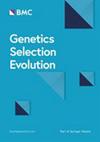高密度全基因组关联研究指出了虹鳟鱼抗感染性胰腺坏死的主要候选基因
IF 3.1
1区 农林科学
Q1 AGRICULTURE, DAIRY & ANIMAL SCIENCE
引用次数: 0
摘要
本研究的重点是对传染性胰腺坏死(IPN)的遗传抗性,这是一种由水生病毒(IPNV)引起的高度传染性疾病,尤其影响全世界的鲑鱼。目的是估计IPN抗性的遗传力,并使用贝叶斯稀疏线性混合模型精细定位数量性状位点(QTL),以确定法国虹鳟鱼商业品系连续两代中可能与IPN抗性相关的候选基因。在5周的时间里,对每一代2000条鱼进行了浸泡暴露于IPNV的实验,每天监测死亡率。所有鱼使用中密度57 K单核苷酸多态性(SNP)芯片进行基因分型,并导入高密度基因型(665 K SNP)。37天后的平均存活率为70%,第二代的存活率高于第一代(78%对61%)。遗传力中等(~ 0.20)。大约74%的IPN抗性遗传变异可以用几十个snp来解释。共在10条染色体上定位了25个QTL,其中在1、14、16和28号染色体上检测到7个QTL。最有趣的QTL与顶级snp相关,在有益和有害纯合基因型之间的平均存活率差异超过20%。这些snp都位于1号染色体(uts2d, rc3h1, ga45b)和16号染色体(irf2bp, eif2ak2)上有希望的功能候选基因上,这些基因都与炎症途径的调节有关。鱼类对IPNV易感性遗传差异的一个关键因素是由eif2ak2基因编码的dsrna依赖性丝氨酸/苏氨酸蛋白激酶(PKR)。所有与1号和16号染色体上最显著QTL相关的基因都参与了炎症途径的调控,这有力地表明炎症在虹鳟鱼IPN抗性中起着核心作用。这些发现为快速传播IPN抗性遗传改良提供了标记辅助选择的可能性。本文章由计算机程序翻译,如有差异,请以英文原文为准。
High-density genome-wide association study points out major candidate genes for resistance to infectious pancreatic necrosis in rainbow trout
This study focuses on genetic resistance to infectious pancreatic necrosis (IPN), a highly contagious disease caused by an aquatic birnavirus (IPNV) which especially affects salmonids worldwide. The objectives were to estimate the heritability of IPN resistance and to fine map quantitative trait loci (QTL) using a Bayesian Sparse Linear Mixed Model to identify candidate genes possibly linked to IPN resistance in two successive generations from a French commercial strain of rainbow trout. For each generation, 2000 fish were experimentally exposed by bath to IPNV and mortalities were monitored daily during 5 weeks. All fish were genotyped using a medium-density 57 K single nucleotide polymorphism (SNP) chip and imputed to high-density genotypes (665 K SNPs). The mean survival rate was 70% after 37 days, with a higher survival rate in the second generation compared to the first one (78% versus 61%). Heritability was moderate (~ 0.20). Approximately 74% of the genetic variance of IPN resistance was explained by several tens of SNPs. In total, 25 QTL were mapped on 10 chromosomes, of which 7 were detected with very strong evidence, on chromosomes 1, 14, 16 and 28. The most interesting QTL were associated to top SNPs with mean survival rate differences over 20% between the beneficial and detrimental homozygous genotypes. Those SNPs were all located within promising functional candidate genes on chromosome 1 (uts2d, rc3h1, ga45b) and chromosome 16 (irf2bp, eif2ak2), which were all associated with regulation of inflammatory pathways. A key factor for the genetic differences in susceptibility to IPNV among fish is the dsRNA-dependent serine/threonine-protein kinase (PKR) encoded by the eif2ak2 gene. All genes associated with the most significant QTL on chromosomes 1 and 16 are involved in the regulation of inflammatory pathways, strongly suggesting a central role of inflammation in IPN resistance in rainbow trout. These findings offer the possibility of marker-assisted selection for rapid dissemination of genetic improvement for IPN resistance.
求助全文
通过发布文献求助,成功后即可免费获取论文全文。
去求助
来源期刊

Genetics Selection Evolution
生物-奶制品与动物科学
CiteScore
6.50
自引率
9.80%
发文量
74
审稿时长
1 months
期刊介绍:
Genetics Selection Evolution invites basic, applied and methodological content that will aid the current understanding and the utilization of genetic variability in domestic animal species. Although the focus is on domestic animal species, research on other species is invited if it contributes to the understanding of the use of genetic variability in domestic animals. Genetics Selection Evolution publishes results from all levels of study, from the gene to the quantitative trait, from the individual to the population, the breed or the species. Contributions concerning both the biological approach, from molecular genetics to quantitative genetics, as well as the mathematical approach, from population genetics to statistics, are welcome. Specific areas of interest include but are not limited to: gene and QTL identification, mapping and characterization, analysis of new phenotypes, high-throughput SNP data analysis, functional genomics, cytogenetics, genetic diversity of populations and breeds, genetic evaluation, applied and experimental selection, genomic selection, selection efficiency, and statistical methodology for the genetic analysis of phenotypes with quantitative and mixed inheritance.
 求助内容:
求助内容: 应助结果提醒方式:
应助结果提醒方式:


